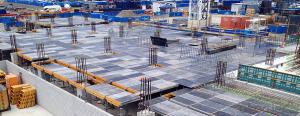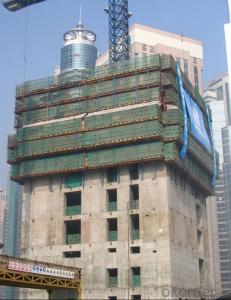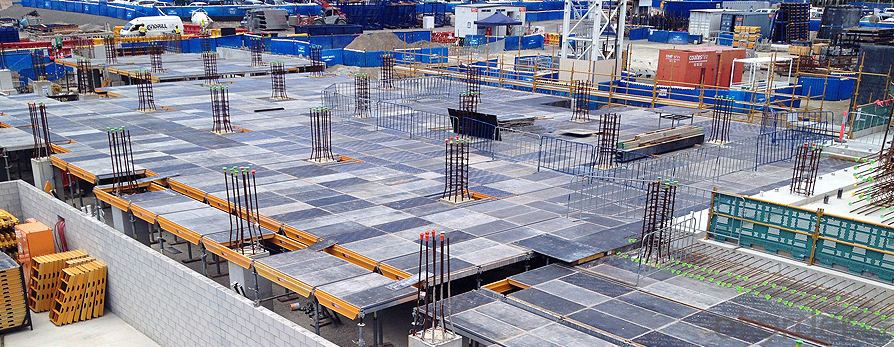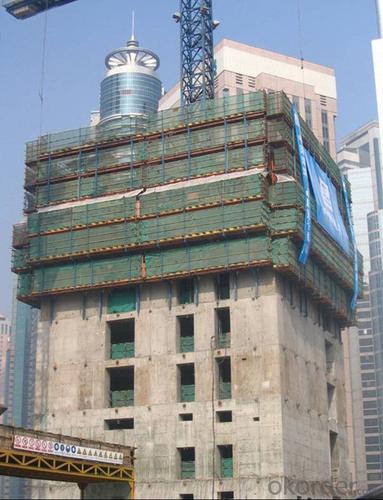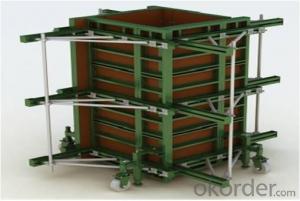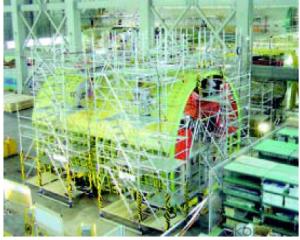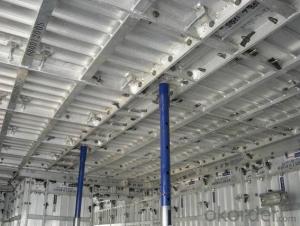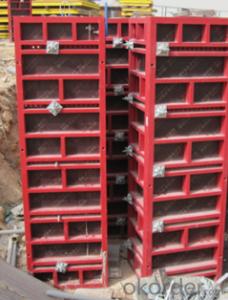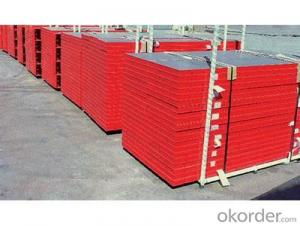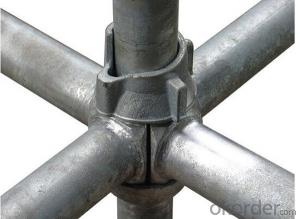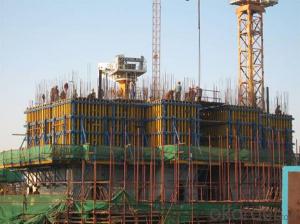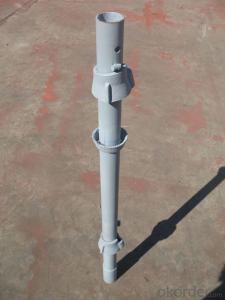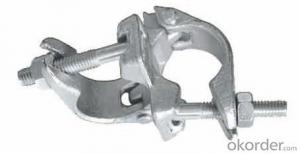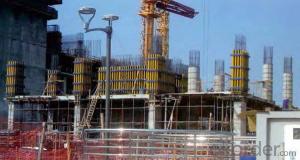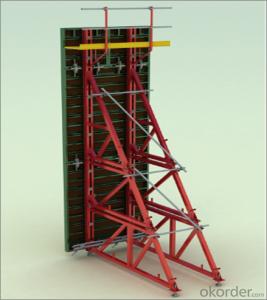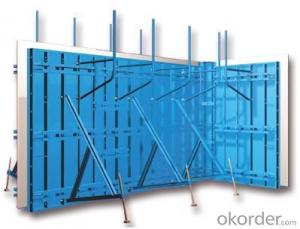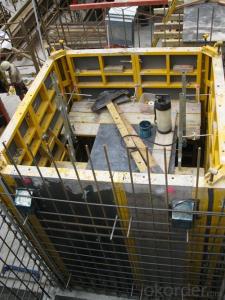Galvanized Scaffolding Formwork Scaffolding Material Specification with High Quality
- Loading Port:
- Tianjin
- Payment Terms:
- TT OR LC
- Min Order Qty:
- 6000 set
- Supply Capability:
- 50000 set/month
OKorder Service Pledge
OKorder Financial Service
You Might Also Like
Galvanized Scaffolding Formwork Scaffolding Material Specification with High Quality
Developing with new technology materials, steel formworks is no longer a must in construction concrete process. More and more buildings are established with plastic formworks. And workers love this new formworks much more.
The advantages of plastic formworks:
1.First of all--light
Yes it is the first advantage of plastic formwork. It wins the great praise of both contractors and workers.
The biggest panel is 120×1500px,weights 10.5kg only. It can be lift and set up by one person easily, which means there is no need for cranes on site.Saves a lot of cost and time.
2.Easy set up
Different size of panels can firmly locked by simply turn the special handles to 90 degree. The Panels has rib on the back, which makes the system need not traditional wood blocks and nails. The panels have holes to fit tie rod, guarantee the strength of the whole system.
3.Modularity
Modular formworks composed by different size of panels..
4.Strength
The handles are made by high strength Nilon, each panel locked by at least 4 handles, which makes the whole system strong enough to pour 1000px walls.
5.Environment friendly
The system needs no cut and nail due to the variety size. Also it needs nearly no wood. The material can be recycled after broken, so it will not pollute the environment.
6.Consequent
Concrete does not stick to plastic formwork, thus the panels need no oil before using, and can be cleaned simply by water. The surface of the wall which build by modular formwork is smooth and without rework.
Galvanized Scaffolding Formwork Scaffolding Material Specification with High Quality
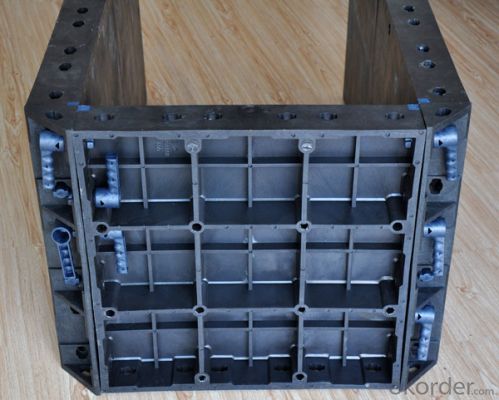
Galvanized Scaffolding Formwork Scaffolding Material Specification with High Quality
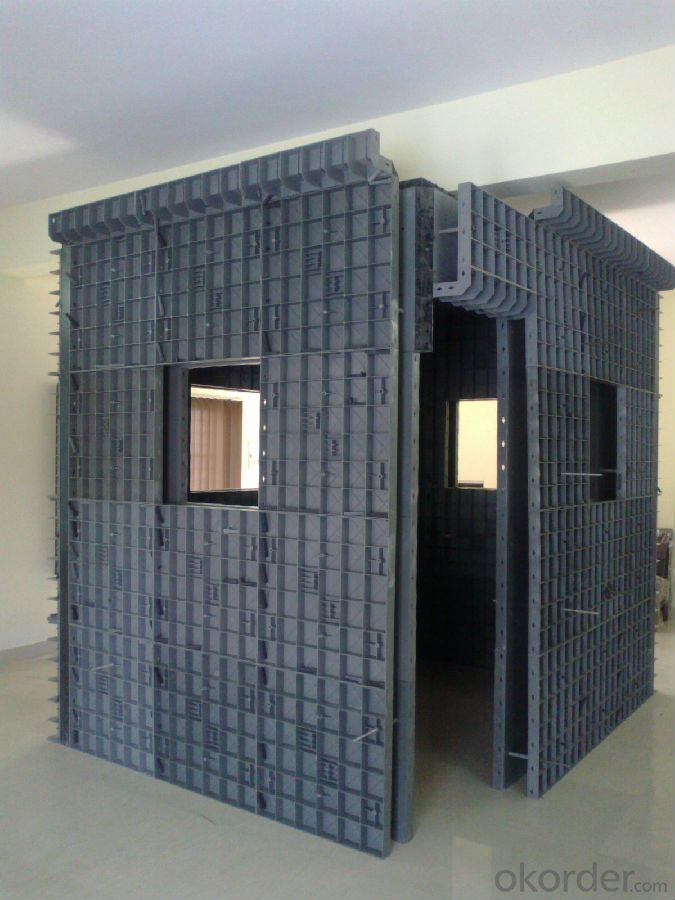
Galvanized Scaffolding Formwork Scaffolding Material Specification with High Quality
Advantage
* Good loading capacity
* Easy to assemble and dismantle
* Stable and durable thanks to its structual design & automatic welding quality
* Customized solution helps you work safe, save cost and convenient
* Excellent quality for formwork & scaffolding with wide choices
Packing
in bulk or in bundle, or as requested
Shipping
15-20 Days.
Normally small orders, it needs just 15-20 business days to the port. For goods with stock, it would be even shoter.
Other scaffolding & formwork products:
(1) Scaffolding System:
Including Ringlock Scaffolding System and accessories; Cuplock Scaffolding System and accessories; Kwikstage Scaffolding System and accessories; Haki Scaffolding System and accessories;
(2) Scaffolding Frame & Accessories:
Including Walk Through Frame Scaffolding; Ladder Frame Scaffolding; Accessories; we also can make scaffolding according to your samples or drawings.
(3) Scaffolding Couplers/Clamps:
We can produce all kinds of forged and pressed couplers, including British type couplers, American type couplers, German type couplers, Italian type couplers ,fence couplers, BRC coplers and so on. We also can produce according to your drawings or samples.
FAQ Galvanized Scaffolding Formwork Scaffolding Material Specification with High Quality
Why Us?
We are one of the Top 500 in the world, largest construction materials supplier in China. Also we are a state-owned company and respond to every customer with large and also small orders.
We own professional manufacturers with powerful producing capacity.
Extensive and comprehensive quality control system
Excellent products with competitive prices.
Efficient services in pre and after sale.
Full energy with affluent experience team.
- Q: PKPM how to add lateral restraint steel frame
- As for the landlord said lateral constraints, generally refers to the vertical component, that is to increase the size of the vertical component size. Or express clearly in question.If you help, please accept, thank you!
- Q: Can steel frame formwork be used in combination with sustainable building materials?
- Indeed, the utilization of steel frame formwork alongside sustainable building materials is a viable option. Steel frame formwork, being a versatile and long-lasting construction system, can serve as the foundational framework for a variety of sustainable building materials, including bamboo, reclaimed wood, and recycled plastic lumber. By integrating these environmentally friendly materials into the formwork system, eco-conscious structures can be constructed. The combination of steel frame formwork and sustainable building materials offers numerous benefits. To begin with, steel is a highly recyclable material, making it a suitable choice for sustainable practices. Moreover, steel frame formwork provides robust structural stability, facilitating the use of lightweight sustainable materials that may not possess the same load-bearing capacity. Furthermore, the amalgamation of steel frame formwork and sustainable building materials can contribute to energy efficiency and decreased environmental impact. For instance, incorporating insulation materials crafted from recycled substances or natural fibers can enhance the building's thermal performance, consequently reducing the demand for heating or cooling energy. It is essential to acknowledge that while steel frame formwork can be utilized with sustainable building materials, the overall sustainability of a construction project relies on various factors, such as the sourcing, manufacturing, and transportation of materials, as well as the employed design and construction methods. Hence, meticulous consideration must be given to ensure that all aspects of the project align with sustainable principles.
- Q: How does steel frame formwork handle different weather conditions?
- Construction projects can rely on steel frame formwork to withstand various weather conditions due to its high resistance. It effectively handles extreme heat, cold, rain, and wind. In hot weather, steel frame formwork remains stable without warping or expanding thanks to its high tensile strength and thermal stability. This ensures the formwork maintains its shape, preventing any deformation or inaccuracies in the concrete structure. During cold weather, steel frame formwork maintains its strength and durability unaffected by low temperatures. This allows construction projects to progress smoothly without compromising quality or safety. Steel frame formwork is also designed to be weatherproof, effectively protecting the concrete from rain and moisture. It prevents water from seeping into the structure, preserving the integrity of the concrete and avoiding potential damage or structural issues. Additionally, steel frame formwork is resistant to wind loads, guaranteeing stability during high winds or storms. Its strong construction and secure anchoring to the ground or adjacent structures make it a reliable choice even in areas prone to strong winds. Overall, steel frame formwork adapts well to different weather conditions, providing stability, durability, and protection to construction projects. Its ability to withstand extreme temperatures, resist water penetration, and handle wind loads make it the preferred choice for various weather conditions, ensuring the successful completion of construction projects with high-quality concrete structures.
- Q: Can steel frame formwork be used for both insulated and non-insulated wall construction?
- Yes, steel frame formwork can be used for both insulated and non-insulated wall construction. Steel frame formwork refers to a system of temporary molds or structures that are used to hold concrete in place during the construction process. These formwork systems are versatile and can be adapted to accommodate different construction requirements, including both insulated and non-insulated wall construction. For insulated wall construction, steel frame formwork can be used to create a mold that accommodates the insulation material, such as foam boards or panels. The formwork system can be designed to include additional features, such as channels or slots, to securely hold the insulation material in place. The concrete is then poured into the formwork, encasing the insulation and creating a strong and insulated wall. For non-insulated wall construction, steel frame formwork can be used in a similar manner, but without the need for accommodating insulation material. The formwork system is simply used to create the mold for the concrete, allowing it to be poured and shaped into the desired wall structure. In summary, steel frame formwork can be used for both insulated and non-insulated wall construction by adapting the design and features of the formwork system to accommodate the specific construction requirements.
- Q: What are the considerations for selecting the appropriate formwork spacing?
- There are several factors that need to be taken into account when choosing the appropriate formwork spacing. To begin with, the type and size of the formwork material play a significant role. Different materials have varying load-bearing capacities, so it is crucial to select a spacing that can adequately support the weight of the poured concrete. Furthermore, the size of the formwork panels also affects the spacing. Larger panels may require closer spacing to prevent sagging or bowing. The height of the formwork is another important consideration. As the height increases, the spacing between supports may need to be decreased to ensure stability and prevent excessive deflection. This is especially important in taller structures where external forces like wind can introduce additional stresses on the formwork. The concrete mix design and pouring technique should also be taken into account. If a high-slump concrete mix is used, it may exert greater pressure on the formwork, necessitating closer spacing to prevent bulging or blowouts. Likewise, if a fast-setting or self-consolidating concrete is being used, the formwork spacing must be chosen to accommodate the rapid pouring and setting process. The expected loads during the construction process must also be considered. If heavy equipment or machinery will be used near the formwork, closer spacing may be necessary to provide extra support and prevent damage. Additionally, the presence of rebar or other reinforcing elements within the concrete should be factored in, as they can increase the load on the formwork and require tighter spacing. Lastly, safety is a crucial aspect when determining formwork spacing. Sufficient spacing should be chosen to allow workers to safely access and maneuver around the formwork. This includes considering the space required for tools, equipment, and proper bracing or scaffolding. In conclusion, the selection of appropriate formwork spacing requires careful consideration of factors such as formwork material, height, concrete mix design, expected loads, and safety requirements. By taking these considerations into account, the formwork can provide the necessary support and stability for successful concrete construction.
- Q: Can steel frame formwork be easily integrated with other construction systems?
- Steel frame formwork offers effortless integration with other construction systems. This versatile and flexible system can be tailored to meet the specific needs of any construction project. It seamlessly combines with scaffolding, slab formwork, and wall formwork, among other systems. The modular design of steel frame formwork enables effortless assembly and disassembly, allowing for compatibility with different construction methodologies. Additionally, it easily adjusts and adapts to accommodate design or construction process changes, ensuring smooth integration with other systems. With its exceptional flexibility and compatibility, steel frame formwork is the perfect choice for integrating with diverse construction systems.
- Q: How does steel frame formwork contribute to better dimensional accuracy in precast elements?
- Steel frame formwork contributes to better dimensional accuracy in precast elements by providing a strong and rigid structure that ensures precise and consistent shaping of the concrete. Firstly, the steel frame formwork is designed and manufactured to meet specific dimensional requirements. This ensures that the formwork itself is accurate and allows for the creation of precise precast elements. The steel material is known for its durability and stability, which prevents any deformation or movement during the concrete pouring process. This stability is crucial for maintaining the correct dimensions of the precast elements. Secondly, the steel frame formwork provides a smooth and even surface for the concrete to be poured into. This reduces the likelihood of any irregularities or inconsistencies in the final product. The steel formwork also allows for easy and precise adjustment of the formwork components, ensuring that the dimensions are maintained throughout the construction process. Furthermore, the steel frame formwork can be reused multiple times, making it a cost-effective solution for achieving dimensional accuracy in precast elements. The ability to reuse the formwork means that the same accurate dimensions can be achieved consistently over multiple projects, without the need for constantly creating new formwork. Overall, the use of steel frame formwork in precast element construction significantly contributes to better dimensional accuracy. Its strength, stability, and reusability ensure that the formwork itself is accurate, and the smooth surface it provides allows for precise shaping of the concrete. By using steel frame formwork, precast elements can be manufactured with consistent dimensions, resulting in high-quality and reliable structures.
- Q: What are the different types of formwork clamps used with steel frame formwork?
- Steel frame formwork commonly utilizes several types of formwork clamps to securely hold the formwork panels in place during the concrete pouring process, ensuring stability and preventing any shifting or movement. One frequently used formwork clamp is the wedge clamp, which consists of a metal wedge inserted into a slot on the formwork panel and tightened to secure it. This clamp is user-friendly, allowing for easy adjustments or removal when necessary. Another commonly employed formwork clamp is the hook clamp, comprising a metal hook inserted into a hole on the formwork panel and tightened to establish a strong and secure connection between the panel and the steel frame. Apart from wedge and hook clamps, other clamp options are available for steel frame formwork. These include spring clamps, utilizing a spring mechanism to hold the formwork panels in place, and toggle clamps, employing a lever mechanism to firmly fasten the panels. These clamps are easily adjustable and provide a reliable and robust connection between the formwork panels and the steel frame. Overall, the various types of formwork clamps used with steel frame formwork offer a range of choices for securely holding the formwork panels. Each clamp type possesses its own advantages and disadvantages, with the selection dependent on the specific requirements of the construction project.
- Q: How does steel frame formwork handle different types of formwork stripping equipment?
- Steel frame formwork offers versatility and durability, effortlessly handling various types of formwork stripping equipment. The steel frames, designed for stability and support, can easily accommodate mechanical or hydraulic systems for stripping. An advantage of steel frame formwork is its ability to withstand the high pressure and force exerted during the stripping process. This is crucial when using different stripping equipment, as a robust support system is necessary for safe and efficient formwork removal. The steel frames are engineered to provide a stable and secure platform for the stripping equipment, ensuring proper alignment and compatibility with various stripping tools. This guarantees secure attachment, enabling effective and efficient formwork removal. Additionally, steel frame formwork is highly adaptable, making it suitable for use with different types of formwork stripping equipment. Whether relying on mechanical force or hydraulic power, the steel frames seamlessly accommodate and work with these diverse equipment options. In conclusion, steel frame formwork is specifically designed to handle various types of formwork stripping equipment. Its strength, stability, and adaptability make it an ideal choice for construction projects requiring efficient and safe formwork removal.
- Q: How does steel frame formwork affect the overall flexibility of construction schedules?
- The overall flexibility of construction schedules can be enhanced with the utilization of steel frame formwork. This is primarily due to the efficiency and speed with which steel frame formwork can be assembled and disassembled. Steel frame formwork is well-known for its durability and strength when compared to other types of formwork. It has the ability to withstand high pressures and loads, enabling faster construction processes. Consequently, construction projects employing steel frame formwork can be completed within shorter time frames, granting more flexibility in scheduling. Moreover, steel frame formwork is highly adaptable and can be easily modified to accommodate design changes or alterations during construction. This adaptability contributes to greater flexibility in construction schedules as adjustments can be swiftly and efficiently made. Additionally, the use of steel frame formwork reduces reliance on conventional timber formwork, which often necessitates longer curing times for concrete. Steel frame formwork facilitates quicker pouring and curing of concrete, thereby expediting the construction process and allowing for greater flexibility in scheduling. In summary, the incorporation of steel frame formwork enhances the overall flexibility of construction schedules by enabling faster construction, facilitating easier modifications, and reducing curing times. This promotes efficient completion of construction projects and provides opportunities to adjust schedules as necessary.
Send your message to us
Galvanized Scaffolding Formwork Scaffolding Material Specification with High Quality
- Loading Port:
- Tianjin
- Payment Terms:
- TT OR LC
- Min Order Qty:
- 6000 set
- Supply Capability:
- 50000 set/month
OKorder Service Pledge
OKorder Financial Service
Similar products
Hot products
Hot Searches
Related keywords
